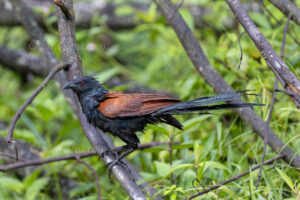 A black and brown bird stands soaking wet on a branch in the curve of the country road. A Greater Coucal (Centropus sinensis) was completely rained on by the tropical storm. Now he stands uncertainly on his branch in front of the approaching car and actually wants to shake himself thoroughly and dry himself. The feathers are completely soaked. His feathers still hang down like wet hair; individual feathers stick out like hairs on a fluffy fur. The proximity of the photographer makes him unsteady, but then the Greater Coucal decides to shake his whole body and then spread his wings and then flap them with casual movements. The colors come out really vivid and rich in contrast. A nice picture.
A black and brown bird stands soaking wet on a branch in the curve of the country road. A Greater Coucal (Centropus sinensis) was completely rained on by the tropical storm. Now he stands uncertainly on his branch in front of the approaching car and actually wants to shake himself thoroughly and dry himself. The feathers are completely soaked. His feathers still hang down like wet hair; individual feathers stick out like hairs on a fluffy fur. The proximity of the photographer makes him unsteady, but then the Greater Coucal decides to shake his whole body and then spread his wings and then flap them with casual movements. The colors come out really vivid and rich in contrast. A nice picture.
On the way to Ba’kelalan in the Malaysian state of Sarawak on the border with Kalimantan, Indonesia, we drive on a wide, rain-soaked track with our Landcruiser 4X4 via Jalan Tanpa Nama, Lawas. The goal is the many good birds that reside in this still very natural and wild part of Borneo.
For birds, cleaning and caring for their feathers is an important hygiene measure and necessary health precaution. The Greater Coucal, for example, takes extensive water and dust baths to rid its many feathers of parasites such as ticks, mites and fleas.
The hedge cuckoo is distributed almost throughout its extensive range and is very common in some areas, particularly much of India and Thailand. Analysis of the DNA suggests that this species is closest to the Javan Coucal (Centropus nigrorufus). Birds from Peninsular Malaysia, Sumatra, Borneo and Palawan are listed as Centropus sinensis bubutus but are sometimes split off into a separate subspecies, eurycercus. Some scientists noted that the voice of bubutus is quite different. However, the previous species assignment to Centropus sinensis is currently being retained in the relevant committees until further investigations shed light on, among other things, the vocal differences.
In order to meet the growing demand for top images of the rarer species of Palaearctic Bird-lens.com has specifically made trips to remote places. Additionally every chance is used, if a rare bird is around the homeground. This to do everything to ensure excellent photos of the Birds of the Western Palearctic. The yield of pictures also of rare Western Palaearctic birds is very good. There are other nice images of birds, that you will find behind the tab “Picture Shop“. Just give a notice if you need a picture of a bird which is not online.